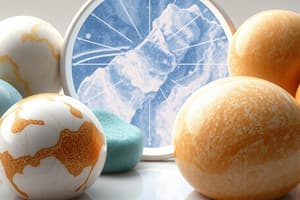Podcast
Questions and Answers
What are most ceramics made of?
What are most ceramics made of?
- Compounds between two nonmetallic elements
- Compounds between metallic and nonmetallic elements (correct)
- A mix of organic and inorganic materials
- Pure metallic elements
What does the term 'ceramic' originate from?
What does the term 'ceramic' originate from?
- The Latin word “ceramica” meaning “heat treatment”
- The Egyptian word “keramos” meaning “nonmetallic substance”
- The Sanskrit word “ceramik” meaning “inorganic material”
- The Greek word “keramikos” meaning “burnt stuff” (correct)
What were the most important materials in the traditional ceramics class primarily made from?
What were the most important materials in the traditional ceramics class primarily made from?
- Clay (correct)
- Metals
- Wood
- Sand
What industries rely on the use of new generation ceramic materials?
What industries rely on the use of new generation ceramic materials?
How have traditional ceramics evolved in recent years?
How have traditional ceramics evolved in recent years?
What are most ceramics primarily composed of?
What are most ceramics primarily composed of?
What does the term 'ceramic' originate from?
What does the term 'ceramic' originate from?
What were the most important materials in the traditional ceramics class primarily made from?
What were the most important materials in the traditional ceramics class primarily made from?
What industries rely on the use of new generation ceramic materials?
What industries rely on the use of new generation ceramic materials?
What process is used to achieve desirable properties of ceramic materials?
What process is used to achieve desirable properties of ceramic materials?
Flashcards are hidden until you start studying
Study Notes
Composition of Ceramics
- Most ceramics are primarily composed of inorganic, non-metallic materials, often silicates, typically based on oxides, nitrides, or carbides.
Origin of the Term 'Ceramic'
- The term 'ceramic' originates from the Greek word 'keramos', meaning potter's clay.
Traditional Ceramics
- The most important materials in the traditional ceramics class were primarily made from clay, silicates, and aluminosilicates.
Industries Relying on New Generation Ceramic Materials
- New generation ceramic materials are used in various industries, including aerospace, automotive, biomedical, energy, and electronics.
Evolution of Traditional Ceramics
- Traditional ceramics have evolved in recent years, with advancements in materials science and technology leading to the development of new generation ceramic materials with improved properties.
Achieving Desirable Properties
- Desirable properties of ceramic materials are achieved through a process involving the manipulation of their microstructure, composition, and processing conditions.
Studying That Suits You
Use AI to generate personalized quizzes and flashcards to suit your learning preferences.




